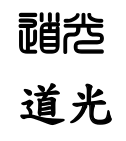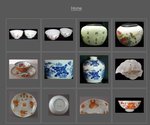Chinese Pottery Marks
found on antique ceramics
Early pottery marks
The earliest pottery markings found on Chinese pottery are from the Qin dynasty (BC248-207), the Han dynasty (BC206-AD220) and the Three Kingdoms Period (220-280).
Marks found on Chinese ceramics are significantly different from
those of European or Japanese antique ceramics. In China porcelain marks or pottery marks on
antiques had mostly a different purpose and another way of expression
than those used in the west since at least the 17th or 18th century. Normally they did not state the manufacturer, so dating based on these marks is almost impossible.
Marks on antique porcelain - Differences between East and West
| Chinese antiques porcelain marks should be one of the last things looked at when trying to identify the age or authenticity of Chinese ceramics. Too often they do not indicate the actual period of manufacture and can only be a part of the overall evaluation. Only a novice will try to find information on a Chinese porcelain item based on the mark. |
|
Novice collectors and those not acquainted with Chinese porcelain often
think they can verify the age or manufacturing location of Chinese
porcelain items using the mark alone, as this would be possible with
western ceramics. NO! it is not possible. Read on below why... |
 |
If you find a manufacturing mark on Chinese ceramics, styled similarly
as the western marks, you can be sure that this item is not that old. In most cases it will be from the early republican period at the best, but more likely to encounter are marks from the 1940s and 50s and later. The habit of showing the manufacturer in marks did
not start before approximately the second quarter of the 20th century.
TO EMPHASIZE THIS AGAIN, IT IS NOT POSSIBLE TO IDENTIFY THE AGE AND
LOCATION OF MANUFACTURE BY THE MARK ALONE WHEN IT COMES TO ANTIQUE
CHINESE PORCELAIN!
If you are looking for information on Chinese porcelain you purchased, do yourself a favour and read this page
first, before posting to internet forums trying to find out if it is
antique or valuable, you could save yourself a lot of time.
Pottery Marks and Chinese Porcelain Manufacturing
Only very few examples of Chinese marks are known to exist on ceramics from times prior to the Ming dynasty
(1368-1644). Marked erarthenware is even more seldom found.
Marking on porcelain really started not before the Yongle reign of this dynasty, but more frequent marking did not begin until the following reigns.
The issue of Chinese marks can be summarized as follows:
- Marks appear most often on Ming and Qing porcelain, earthenware is seldom marked, with the exception of Yixing tea wares.
- Most export porcelain was never marked at all. Actually, most of the porcelain for the domestic market also was never marked.
- Before the middle of the 19th century almost all marks were hand-painted. This means there will be some irregular features as most handmade things have.
- From around middle of the 19th century red stamps were often used.
- From the beginning of the 1890s the word "CHINA", in English, in red and applied in red with a rubber stamp would have been present on many export items.
- From about 1919 "Made in China" would have been applied on many export porcelains.
- A very clean, regular mark looking like those used in western countries, is a sign that an item probably was produced much later in the 20th century, and is unlikely antique. However, this does not mean that china antiques porcelain marks that were hand-painted are all antique. Later copies and fakes also do have hand-painted marks. Even contemporary items may have hand-painted marks.
- The kiln name was never mentioned in antique marks.
So how can we know where or when some ceramic item was made?
More often than not it is difficult to impossible to locate where in China a specific item was made.
The number of ancient kilns is
staggering, and so is the number of marks - and the latter do not mention the kiln they were manufactured at. With some specific items or decoration types, especially pre-Ming this might be possible, but with the majority of Ming and Qing porcelain items it is difficult.
See this page for an overview over the number of ancient kilns known. Be aware, however, that this list mentions only the main kilns or kiln systems. Some kiln systems consisted of hundreds of nameless individual kilns.
Despite all this, collecting Chinese porcelain is fascinating and you
are encouraged to study Chinese ceramics deeper. It can be very
rewarding.
Pottery Marks on Earthenware
Earthenware items were always the most unlikely to be marked in China. However there is an exception - Yixing tea wares. These were (and still are today) frequently marked, but in a different way than other ceramics. Usually the show the name of the master craftsman making them, rather than a reign mark. (See Yixing wares.)
Porcelain Marks
Predominant character styles used in pottery marks of the Qing dynasty:
The predominant character style is given for each Qing dynasty reign as used in marked items made at the
official (imperial kiln) at Jingdezhen. This is just a general guideline. It does not completely exclude
the use of another style, as there were always exceptions. In other words, this involves the
likelihood or probability for the use of a mark style, when it comes to evaluation of marked items. And, this concerns only 'reign'
marks. Reign marks are marks which mention the reign (emperor's reign
name) and/or the dynasty. Reign marks were used by both the official
kiln and the private kilns.
However, marks applied by private kilns were subject to
fewer restrictions or regulations by the imperial court. Thus, in some reigns a multitude of different character types
and mark variations exist.
In the Ming dynasty most reign marks, either from official or
private kilns, were written in a Kaishu or a similar style. In the Ming
dynasty marks in a Zhuanshu type of Zhuanshu of characters are known
only from the Yongle reign (see Ming Emperors.
However, only a handful of authentic marked items from that reign are known to
exist, and the museums were they are located are exactly known. Any
Yongle marks on antique items were applied either later in the Ming
dynasty, or are considered modern fakes.
| Reign | Character style of marks | |
| Shunzhi | 1644-1661 | Kaishu style (no imperial marks?) |
| Kangxi | 1662-1722 | Kaishu style |
| Yongzheng | 1723-1735 | Kaishu style |
| Qianlong | 1736-1795 | Zhuanshu style |
| Jiaqing | 1796-1820 | Zhuanshu style (imperial) |
| Daoguang | 1821-1850 | Zhuanshu/Kaishu styles |
| Xianfeng | 1851-1861 | Kaishu style |
| Tongzhi | 1862-1874 | Kaishu style |
| Guangxu | 1875-1908 | Kaishu style |
| Xuantong | 1909-1911 | Kaishu style |
|
Example: |
 |
Kaishu style |
Antique Pottery Marks and Their Use in Authentication
During an overall evaluation of an item the style of mark characters
can be an additional hint as to the likelihood or improbability in view
to authenticity.
For example, if an item has a mark using the Kaishu character style, and
is supposed to be from the Qianlong reign, then something could be
fishy. Most period reign on items from the Qianlong reign, whether made
at the imperial or private kilns, would have used Zhuanshu characters.
Zhuanshu characters are an
archaic character type used mainly in seals (seal marks).
Much of the above is only valid for porcelain. The only other ceramics
which were commonly marked are Yixing pottery items. The unglazed
Yixing teapots are marked almost without exception. However, reign marks
on Yixing pottery are an exception. Vintage or antique pottery marks
are frequently of the seal mark type mentioned above.
These types
of wares are usually marked by the workshop, manufacturer or artisan
making them, or in some cases perhaps with the mark of the client who
ordered them.
The character style can vary with such pottery marks.
Finally, collectors should recognize the order of writing characters in the old times:
- Marks written horizontally were written on a single line, from right to left.
- Marks written vertically were written from the top down.
- Marks with more than one line/column were written top down, from right to left, in that order.
(X) Any marks on Chinese porcelain that are written left to right, or from top down, left to right, mean that the item having these were made in recent times.
Comment regarding Chinese terms:
(Use of Kaishu/Kaiti and Zhuanshu/Zhuanti)
Example: Kaishu - means Kai style 'writing'; Kaiti means Kai style 'characters' (aka 'font')
More on Chinese marks
Home » Marks » Pottery Marks
Last update: 8. Aug. 2024



